Reconstruction of Lamb Wave Dispersion Curves in Different Objects Using Signals Measured at Two Different Distances
Abstract
:1. Introduction
2. Methods and Numerical Investigation of Performance
2.1. Method of Two Signals Analysis
2.2. 2D-FFT Method
2.3. Procedure for the Performance Investigation of Methods
2.4. Numerical Investigation of the Methods
3. Experimental Research
3.1. Example of the Polyvinyl Chloride Film
3.2. Example of the Wind Turbine Blade
4. Conclusions
Author Contributions
Funding
Institutional Review Board Statement
Informed Consent Statement
Data Availability Statement
Acknowledgments
Conflicts of Interest
References
- Su, Z.; Ye, L.; Lu, Y. Guided Lamb waves for identification of damage in composite structures: A review. J. Sound Vib. 2006, 295, 753–780. [Google Scholar] [CrossRef]
- Zuo, H.; Yang, Z.; Xu, C.; Tian, S.; Chen, X. Damage identification for plate-like structures using ultrasonic guided wave based on improved MUSIC method. Compos. Struct. 2018, 203, 164–171. [Google Scholar] [CrossRef]
- Cawley, P.; Lowe, M.J.S.; Alleyne, D.N.; Pavlakovic, B.; Wilcox, P. Practical long range guided wave testing: Applications to pipes and rail. Mater. Eval. 2003, 61, 66–74. [Google Scholar]
- Papanaboina, M.R.; Jasiuniene, E. The defect identification and localization using ultrasonic guided waves in aluminum alloy. In Proceedings of the 2021 IEEE 8th International Workshop on Metrology for AeroSpace (MetroAeroSpace), Naples, Italy, 23–25 June 2021. [Google Scholar] [CrossRef]
- Barski, M.; Pająk, P. Determination of dispersion curves for composite materials with the use of stiffness matrix method. Acta Mech Autom. 2017, 11, 121–128. [Google Scholar] [CrossRef] [Green Version]
- Kuznetsov, S.V. Abnormal dispersion of Lamb waves in stratified media. Z. Angew. Math. Phys. 2019, 70, 175. [Google Scholar] [CrossRef]
- Wu, B.; Huang, Y.; Chen, X.; Krishnaswamy, S.; Li, H. Guided-wave signal processing by the sparse Bayesian learning approach employing Gabor pulse model. Struct. Health Monit. 2017, 16, 347–362. [Google Scholar] [CrossRef]
- Wilcox, P.; Lowe, M.; Cawley, P. Effect of dispersion on long-range inspection using ultrasonic guided waves. NDT E Int. 2001, 34, 1–9. [Google Scholar] [CrossRef]
- Luo, Z.; Zeng, L.; Lin, J. A novel time–frequency transform for broadband Lamb waves dispersion characteristics analysis. Struct. Health Monit. 2021, 20, 3056–3074. [Google Scholar] [CrossRef]
- Ghose, B.; Panda, R.S.; Balasubramaniam, K. Phase velocity measurement of dispersive wave modes by Gaussian peak-tracing in the f-k transform domain. Meas. Sci. Technol. 2021, 32, 124006. [Google Scholar] [CrossRef]
- Abdulaziz, A.H.; Hedaya, M.; Elsabbagh, A.; Holford, K.; McCrory, J. Acoustic emission wave propagation in honeycomb sandwich panel structures. Compos. Struct. 2021, 277, 114580. [Google Scholar] [CrossRef]
- Hu, Y.; Zhu, Y.; Tu, X.; Lu, J.; Li, F. Dispersion curve analysis method for Lamb wave mode separation. Struct. Health Monit. 2020, 19, 1590–1601. [Google Scholar] [CrossRef]
- Ren, B.; Lissenden, C.J. PVDF multielement lamb wave sensor for structural health monitoring. IEEE Trans. Ultrason. Ferroelectr. Freq. Control 2016, 63, 178–185. [Google Scholar] [CrossRef]
- Lašová, Z.; Zemčík, R. Determination of group velocity of propagation of lamb waves in aluminium plate using piezoelectric transducers. Appl. Comput. Mech. 2017, 11, 23–32. [Google Scholar] [CrossRef]
- Memmolo, V.; Boffa, N.D.; Maio, L.; Monaco, E.; Ricci, F. Damage localization in composite structures using a guided waves based multi-parameter approach. Aerospace 2018, 5, 111. [Google Scholar] [CrossRef] [Green Version]
- Yu, T.H. Plate waves scattering analysis and active damage detection. Sensors 2021, 21, 5458. [Google Scholar] [CrossRef]
- Day, D.; He, Q. Structure damage localization with ultrasonic guided waves based on a time-frequency method. Signal Process. 2014, 96, 21–28. [Google Scholar] [CrossRef]
- Harb, M.S.; Yuan, F.G. Non-contact ultrasonic technique for Lamb wave characterization in composite plates. Ultrasonics 2016, 64, 162–169. [Google Scholar] [CrossRef]
- Chen, Q.; Xu, K.; Ta, D. High-resolution Lamb waves dispersion curves estimation and elastic property inversion. Ultrasonics 2021, 115, 106427. [Google Scholar] [CrossRef]
- Xu, K.; Laugier, P.; Minonzio, J.-G. Dispersive Radon transform. J. Acoust. Soc. Am. 2018, 143, 2729. [Google Scholar] [CrossRef]
- Draudviliene, L.; Tumsys, O.; Mazeika, L.; Zukauskas, E. Estimation of the Lamb wave phase velocity dispersion curves using only two adjacent signals. Compos. Struct. 2021, 258, 113174. [Google Scholar] [CrossRef]
- Plastics Europe (2019)—Association of Plastics Manufacturers. Plastics—The Facts 2019 An Analysis of European Plastics Production, Demand and Waste Data. Available online: https://www.plasticseurope.org/en/resources/publications/4312-plastics-facts-2020 (accessed on 15 April 2021).
- Paletta, A.; Leal Filho, W.; Balogun, A.L.; Foschi, E.; Bonoli, A. Barriers and challenges to plastics valorisation in the context of a circular economy: Case studies from Italy. J. Clean. Prod. 2019, 241, 118149. [Google Scholar] [CrossRef]
- Penca, J. European Plastics Strategy: What promise for global marine litter? Mar. Policy 2018, 97, 197–201. [Google Scholar] [CrossRef]
- Khan, J.G.; Dalu, R.S.; Gadekar, S.S. Defects in extrusion process and their impact on product quality. Int. J. Mech. Eng. Robot Res. 2014, 3, 187–194. [Google Scholar]
- Patil, P.M.; Sadaphale, D.B. A Study of Plastic Extrusion Process and its Defects. Int. J. Latest Technol. Eng. Manag. Appl. Sci. 2018, 7, 13–20. [Google Scholar]
- Kažys, R.; Šliteris, R.; Mažeika, L.; Tumšys, O.; Žukauskas, E. Attenuation of a slow subsonic A0 mode ultrasonic guided wave in thin plastic films. Materials 2019, 12, 1648. [Google Scholar] [CrossRef] [Green Version]
- Chipindula, J.; Botlaguduru, V.S.V.; Du, H.; Kommalapati, R.R.; Huque, Z. Life cycle environmental impact of onshore and offshore wind farms in Texas. Sustainaiblity 2018, 10, 2022. [Google Scholar] [CrossRef] [Green Version]
- Abo-Khalil, A.G. Impacts of Wind Farms on Power System Stability. Model. Control Asp. Wind Power Syst. 2013, 7, 4935. [Google Scholar] [CrossRef] [Green Version]
- Feng, J. Wind farm site selection from the perspective of sustainability: A novel satisfaction degree-based fuzzy axiomatic design approach. Int. J. Energy Res. 2021, 45, 1097–1127. [Google Scholar] [CrossRef]
- Zhang, Y.; Cui, Y.; Xue, Y.; Liu, Y. Modeling and Measurement Study for Wind Turbine Blade Trailing Edge Cracking Acoustical Detection. IEEE Access 2020, 8, 105094–105103. [Google Scholar] [CrossRef]
- Mishnaevsky, L.; Branner, K.; Petersen, H.N.; Beauson, J.; McGugan, M.; Sørensen, B.F. Materials for wind turbine blades: An overview. Materials 2017, 10, 1285. [Google Scholar] [CrossRef] [Green Version]
- Car, M.; Markovic, L.; Ivanovic, A.; Orsag, M.; Bogdan, S. Autonomous Wind-Turbine Blade Inspection Using LiDAR-Equipped Unmanned Aerial Vehicle. IEEE Access. 2020, 8, 131380–131387. [Google Scholar] [CrossRef]
- Tiwari, K.A.; Raisutis, R. Identification and characterization of defects in glass fiber reinforced plastic by refining the guided lamb waves. Materials 2018, 11, 1173. [Google Scholar] [CrossRef] [PubMed] [Green Version]
- Draudviliene, L.; Meskuotiene, A.; Tumsys, O.; Mazeika, L.; Samaitis, V. Metrological Performance of Hybrid Measurement Technique Applied for the Lamb Waves Phase Velocity Dispersion Evaluation. IEEE Access 2020, 8, 45985–45995. [Google Scholar] [CrossRef]
- Sorohan, Ş.; Constantin, N.; Gǎvan, M.; Anghel, V. Extraction of dispersion curves for waves propagating in free complex waveguides by standard finite element codes. Ultrasonics 2011, 51, 503–515. [Google Scholar] [CrossRef]
- Pavlakovic, B.; Lowe, M. Disperse User’s Manual; Non-Destructive Testing Laboratory Department of Mechanical Engineering Imperial College London: London, UK, 2013; p. 207. Available online: https://www.scribd.com/document/410429651/disperse-manual-pdf (accessed on 15 April 2021).
- Alleyne, D.; Cawley, P. A two-dimensional Fourier transform method for the measurement of propagating multimode signals. J. Acoust. Soc. Am. 1991, 89, 1159–1168. [Google Scholar] [CrossRef]
- Frank Pai, P.; Deng, H.; Sundaresan, M.J. Time-frequency characterization of lamb waves for material evaluation and damage inspection of plates. Mech. Syst. Signal Process. 2015, 62, 183–206. [Google Scholar] [CrossRef]
- United States Plastics Corporation, Typical Physical Properties: Vintec® Clear PVC. Available online: http://www.usplastic.com/catalog/files/specsheets/Clear%20PVC%20-%20Vycom.pdf (accessed on 15 April 2021).
- Vladišauskas, A.; Šliteris, R.; Raišutis, R.; Seniūnas, G.; Žukauskas, E. Contact ultrasonic transducers for mechanical scanning systems. Ultragarsas/Ultrasound 2010, 65, 30–35. [Google Scholar]
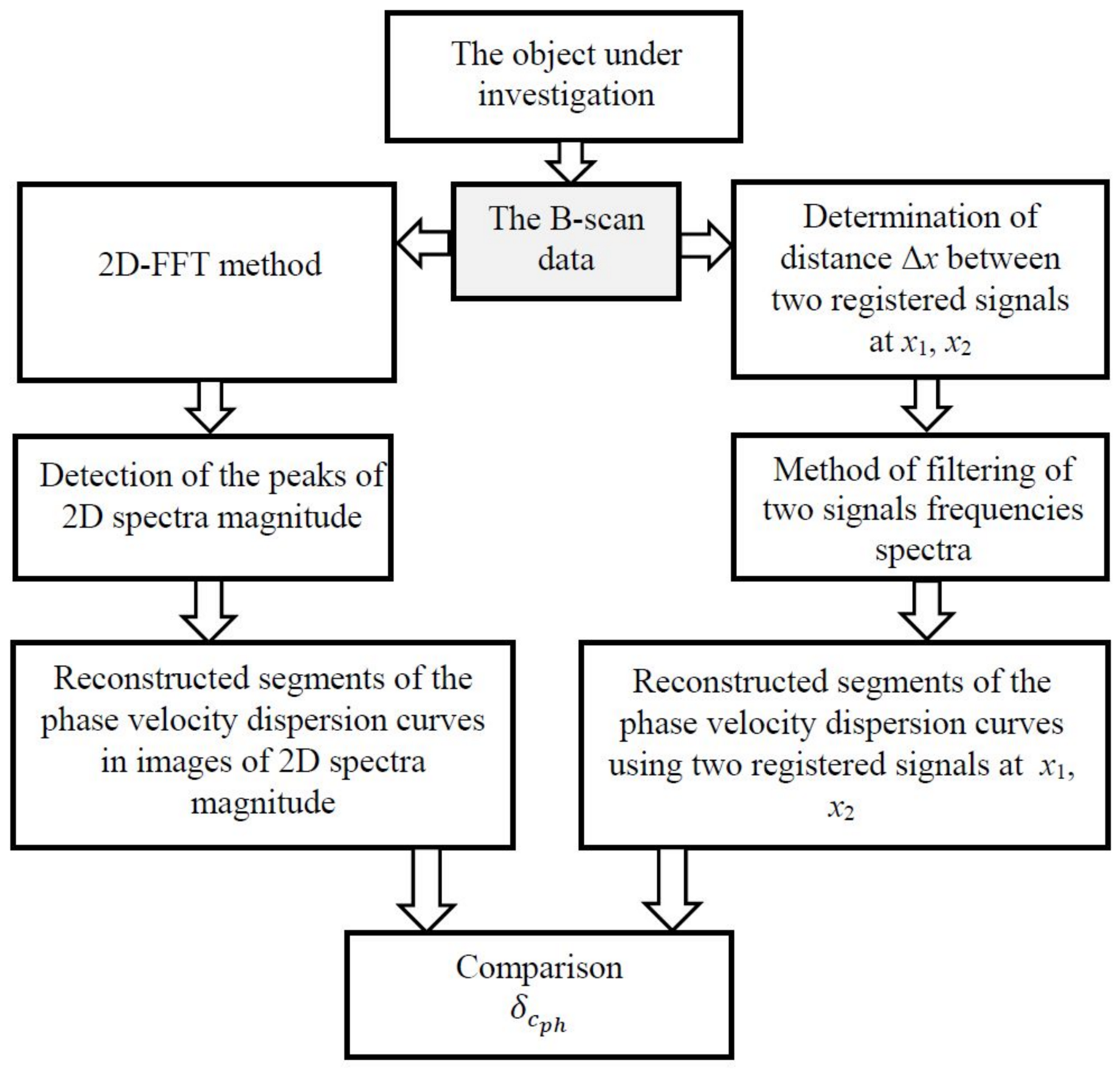
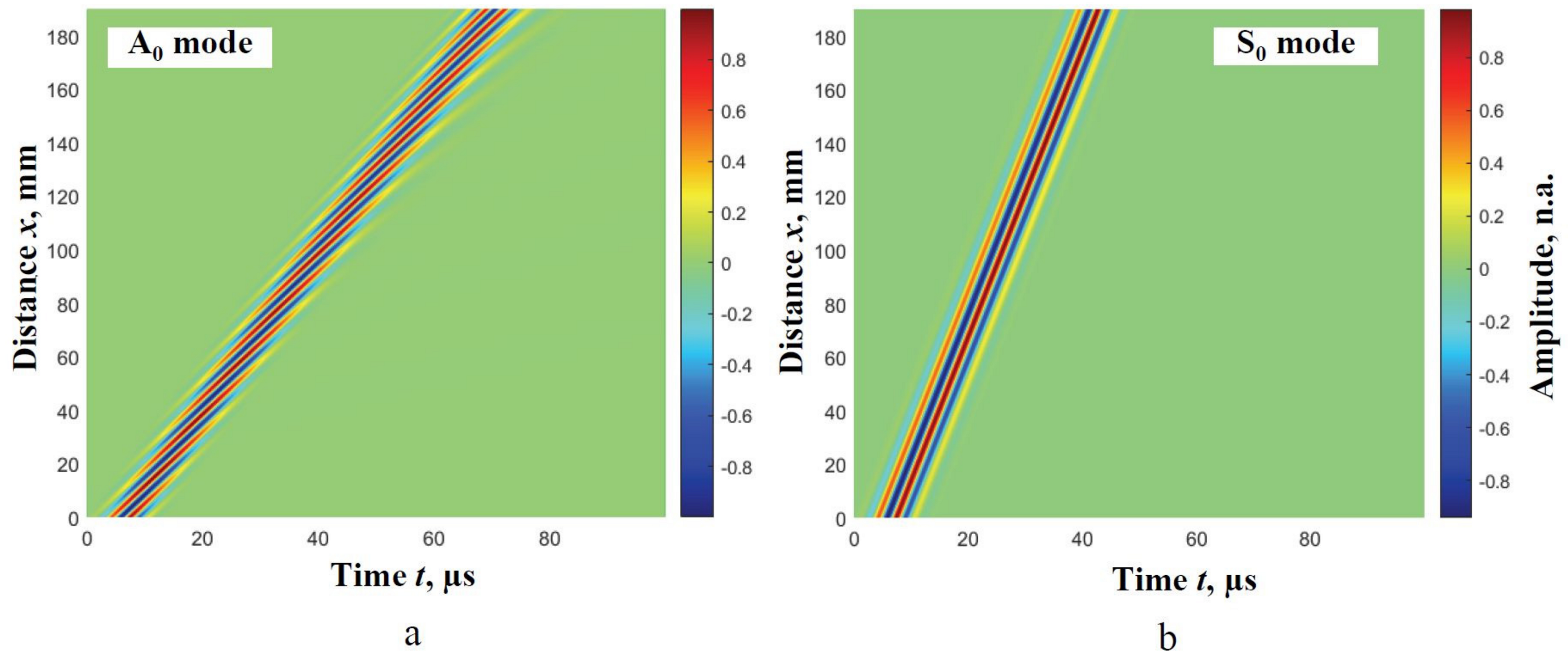
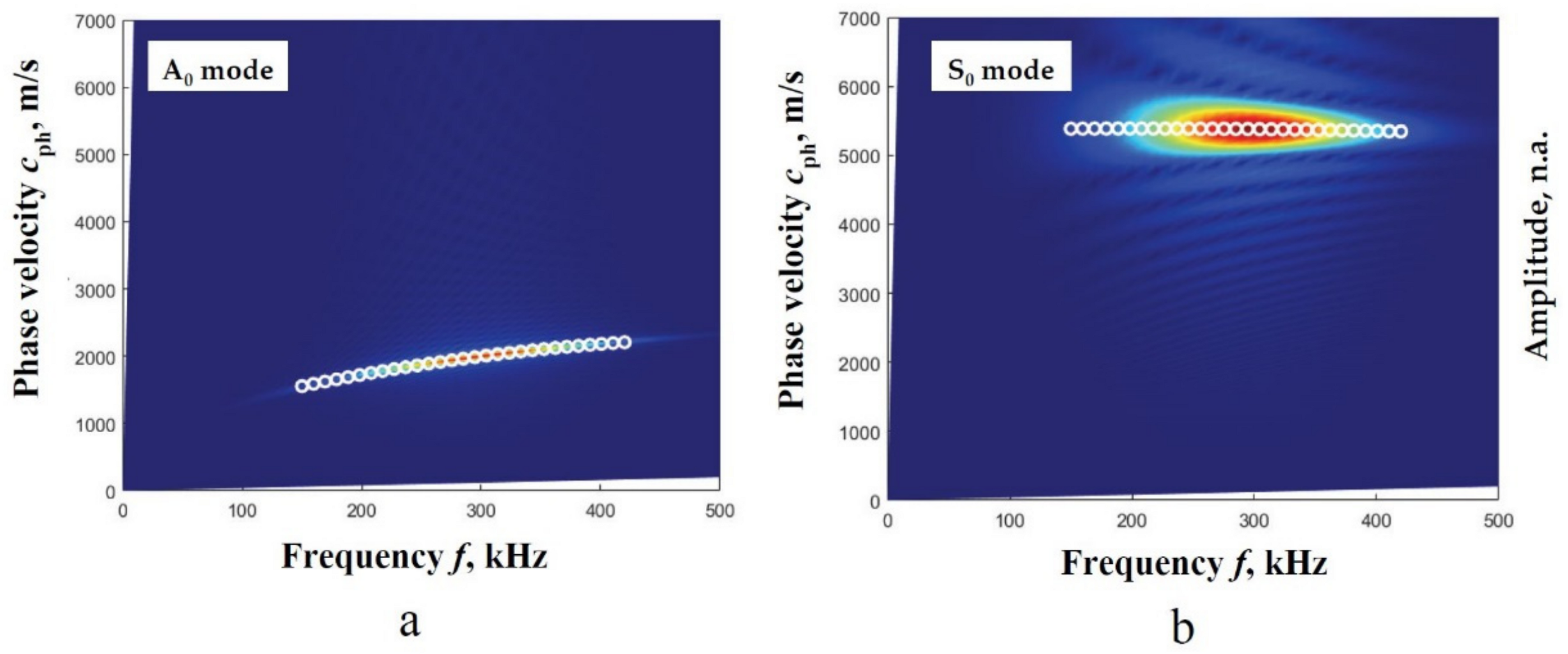
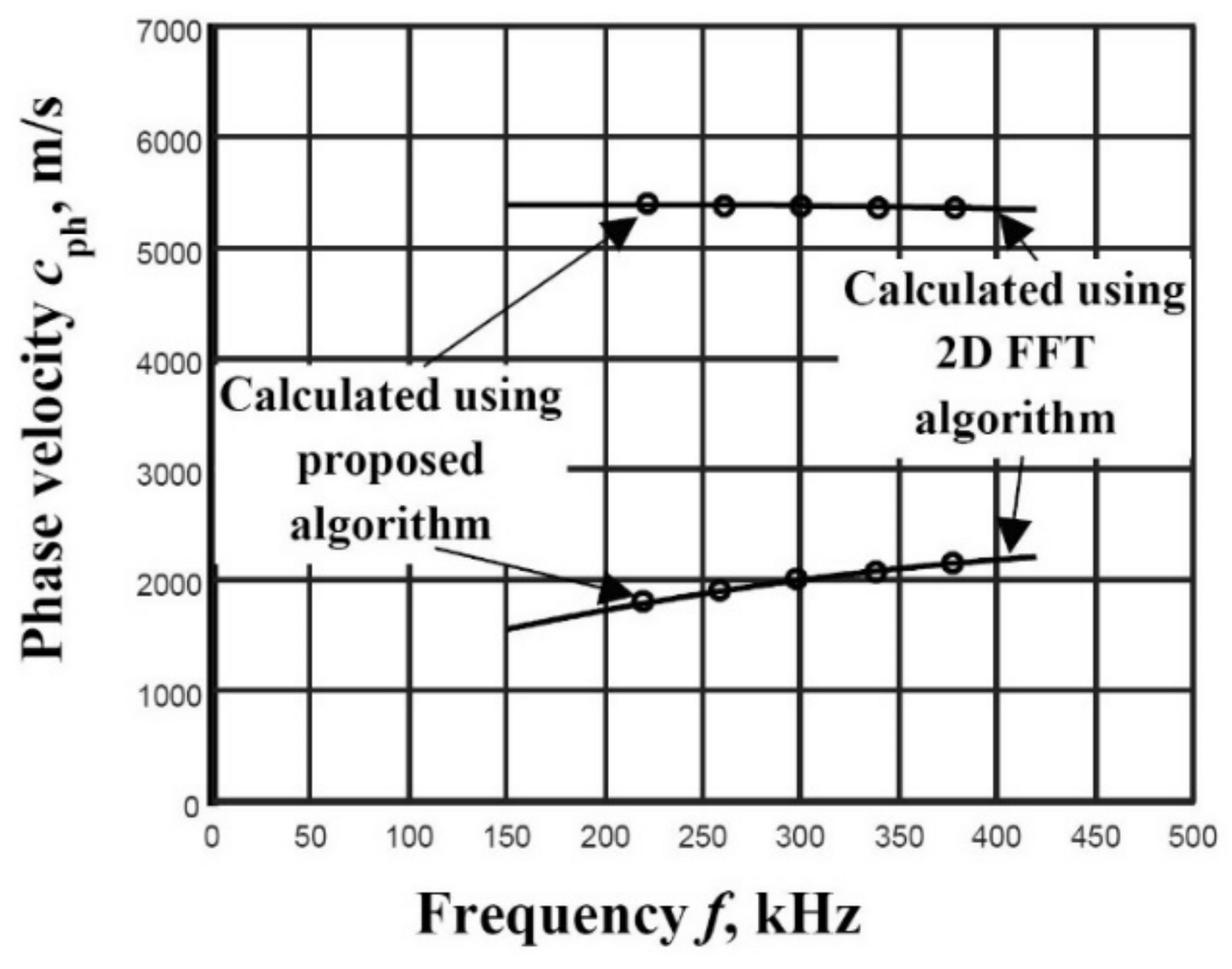

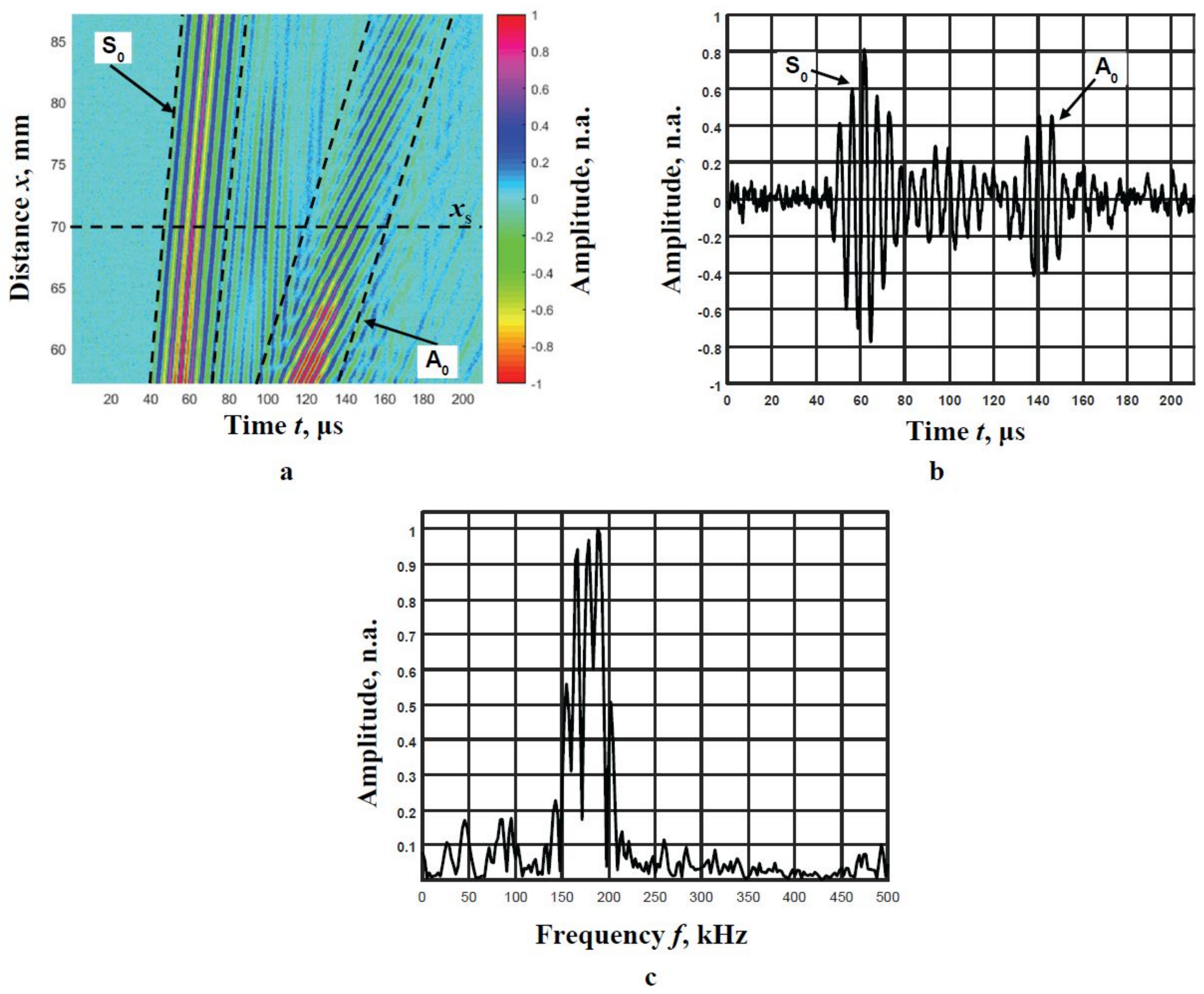
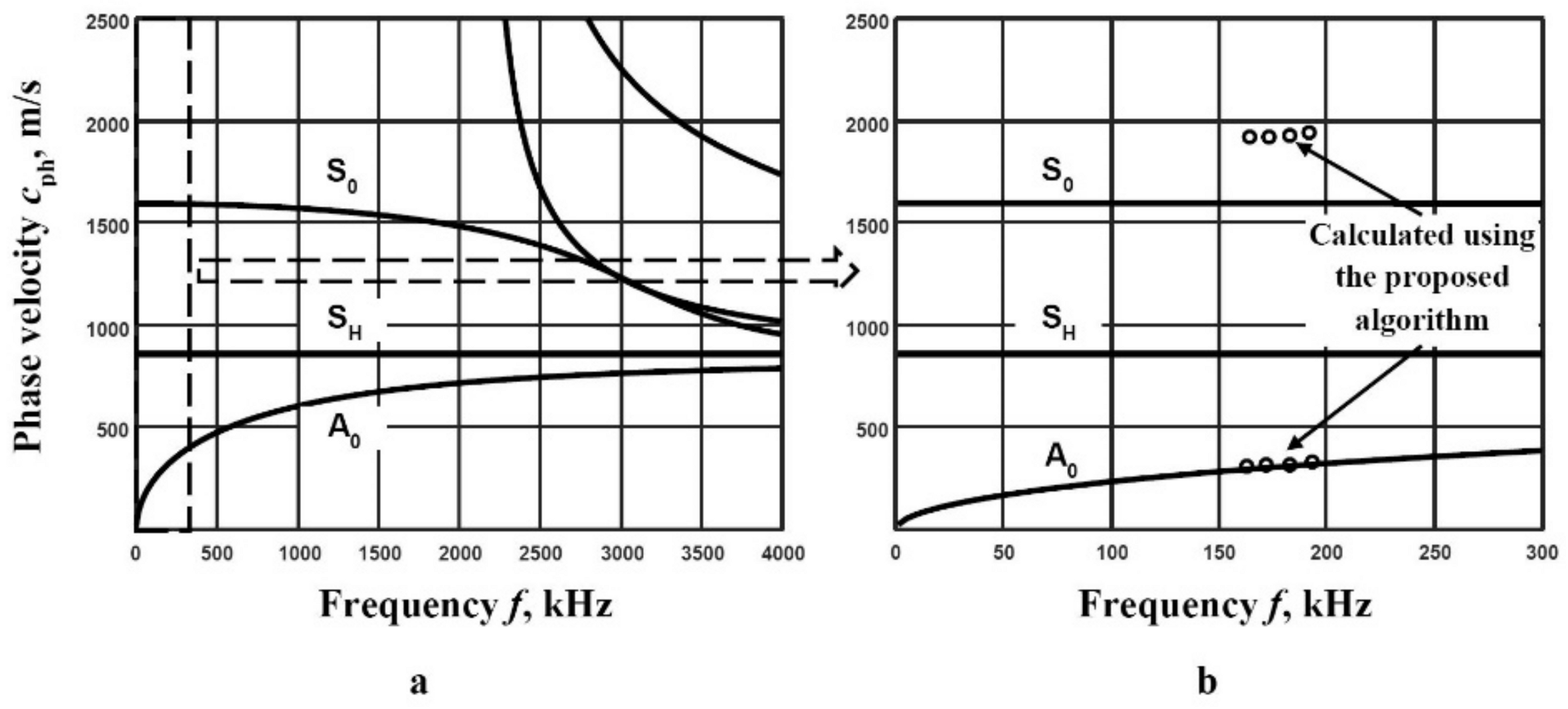
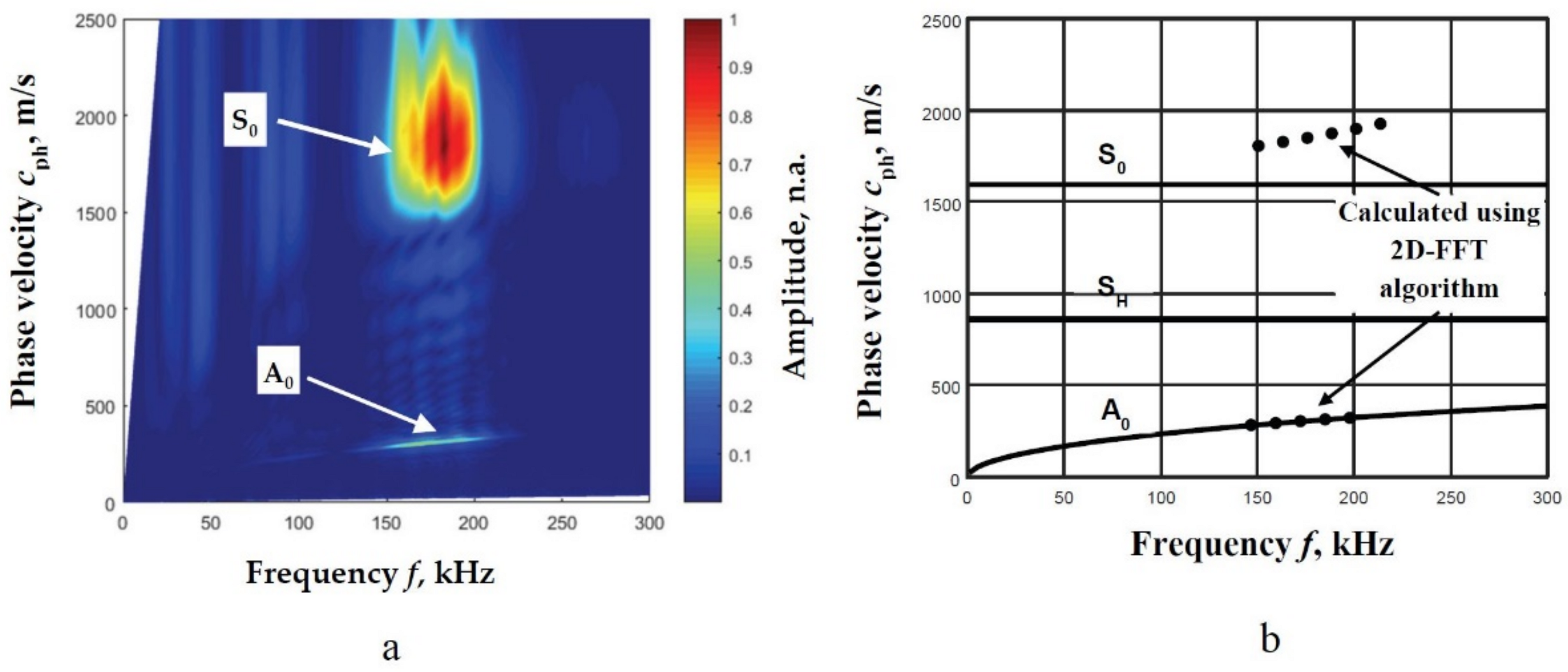
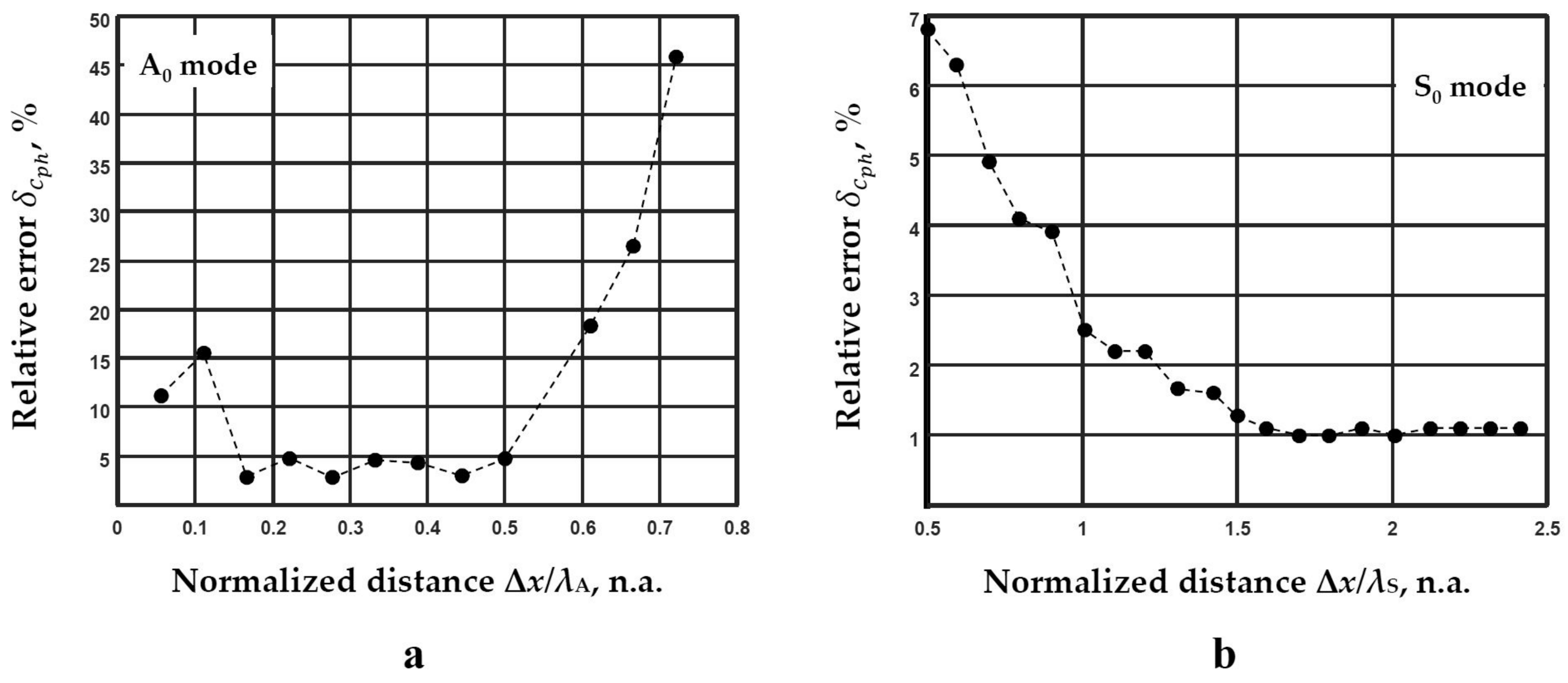
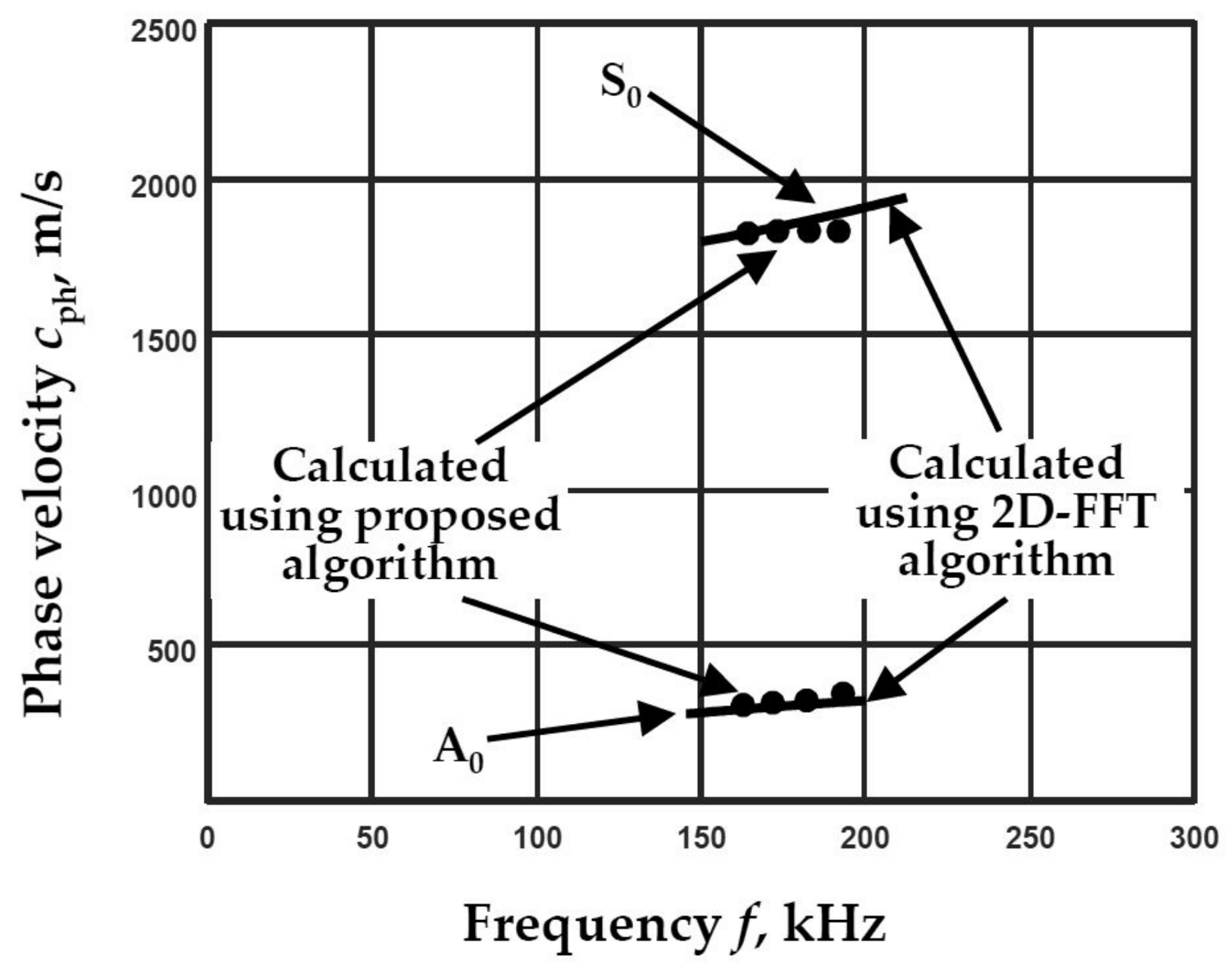
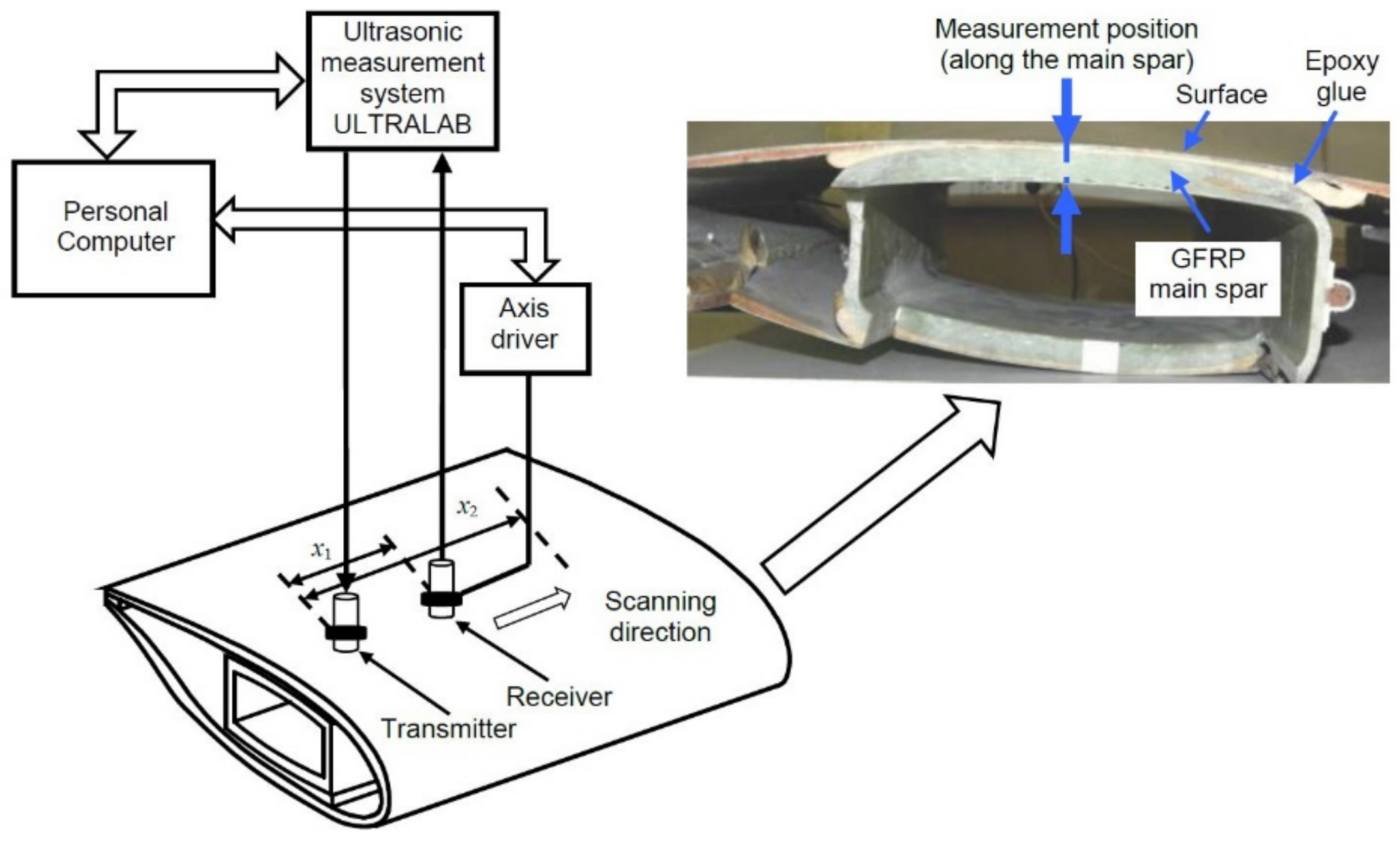

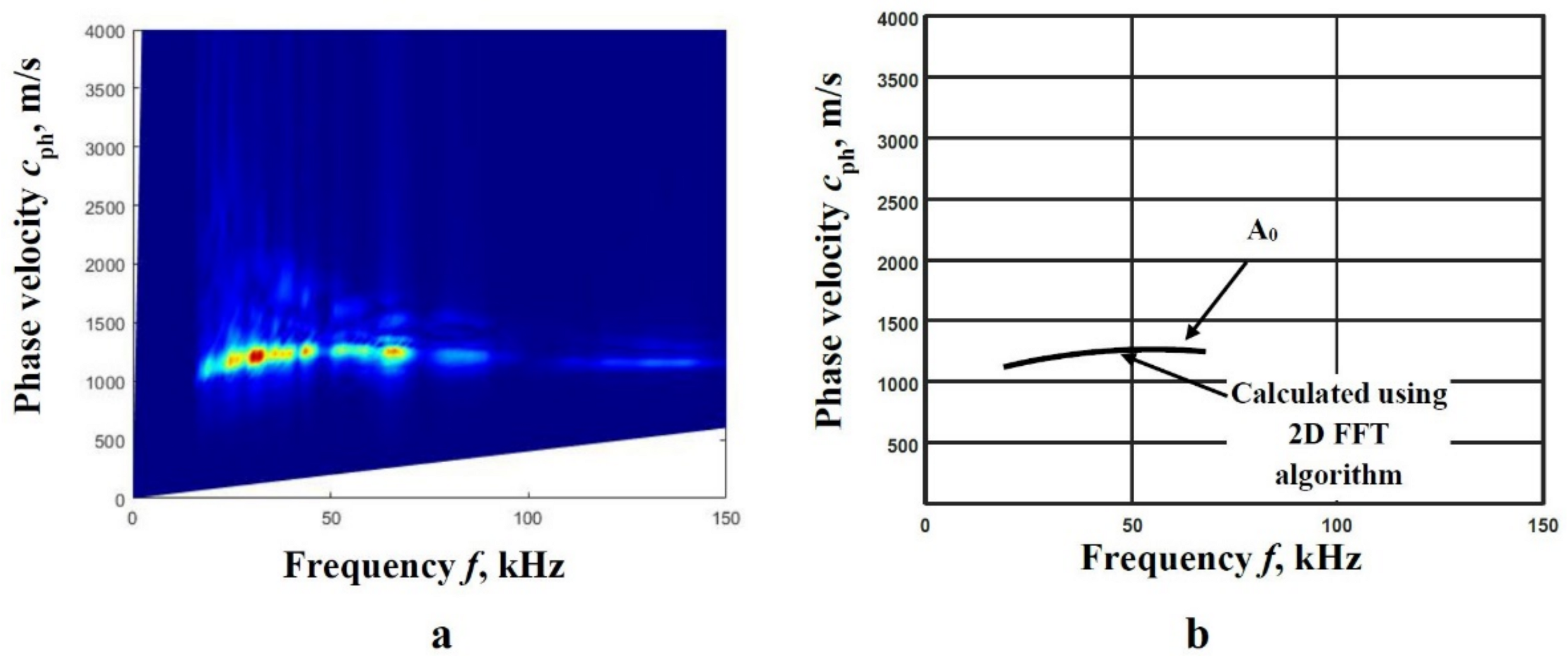
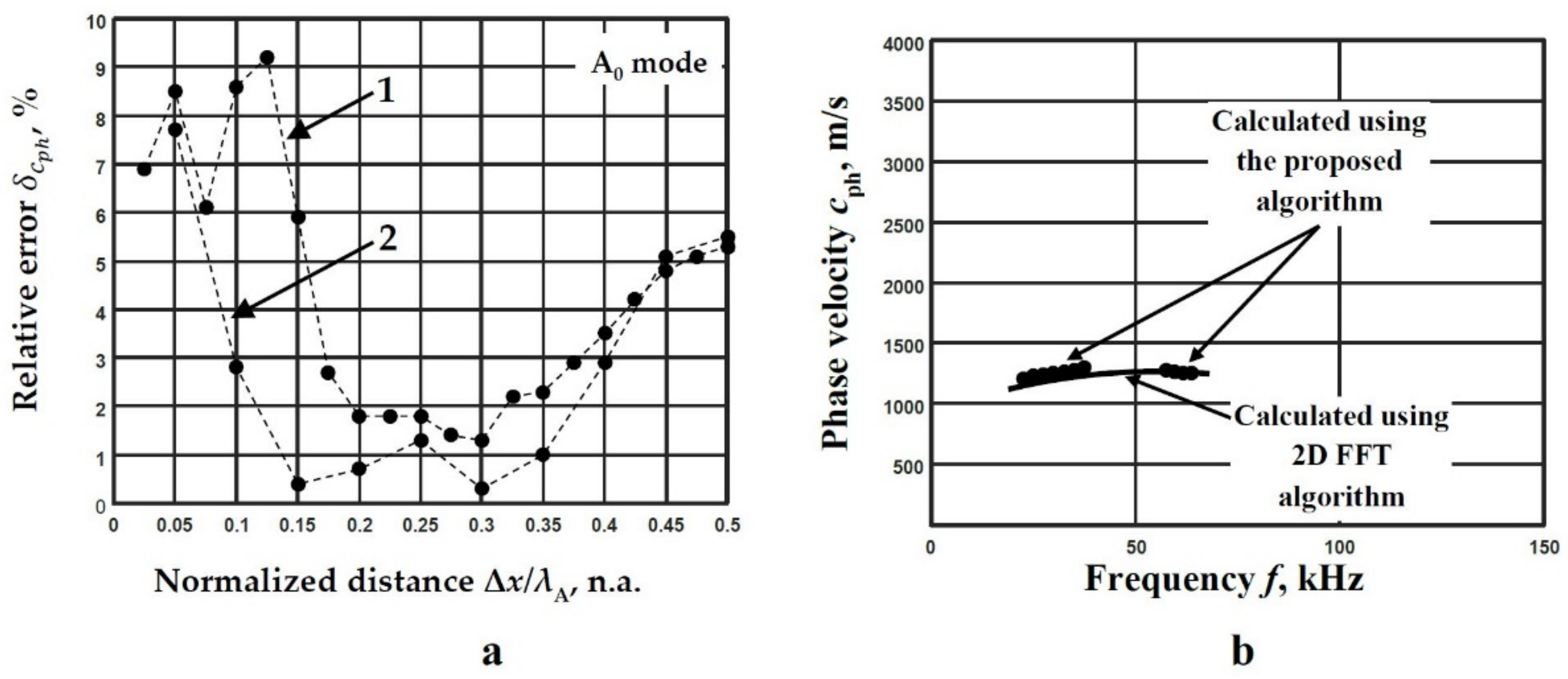
Publisher’s Note: MDPI stays neutral with regard to jurisdictional claims in published maps and institutional affiliations. |
© 2021 by the authors. Licensee MDPI, Basel, Switzerland. This article is an open access article distributed under the terms and conditions of the Creative Commons Attribution (CC BY) license (https://creativecommons.org/licenses/by/4.0/).
Share and Cite
Draudvilienė, L.; Tumšys, O.; Raišutis, R. Reconstruction of Lamb Wave Dispersion Curves in Different Objects Using Signals Measured at Two Different Distances. Materials 2021, 14, 6990. https://doi.org/10.3390/ma14226990
Draudvilienė L, Tumšys O, Raišutis R. Reconstruction of Lamb Wave Dispersion Curves in Different Objects Using Signals Measured at Two Different Distances. Materials. 2021; 14(22):6990. https://doi.org/10.3390/ma14226990
Chicago/Turabian StyleDraudvilienė, Lina, Olgirdas Tumšys, and Renaldas Raišutis. 2021. "Reconstruction of Lamb Wave Dispersion Curves in Different Objects Using Signals Measured at Two Different Distances" Materials 14, no. 22: 6990. https://doi.org/10.3390/ma14226990
APA StyleDraudvilienė, L., Tumšys, O., & Raišutis, R. (2021). Reconstruction of Lamb Wave Dispersion Curves in Different Objects Using Signals Measured at Two Different Distances. Materials, 14(22), 6990. https://doi.org/10.3390/ma14226990





